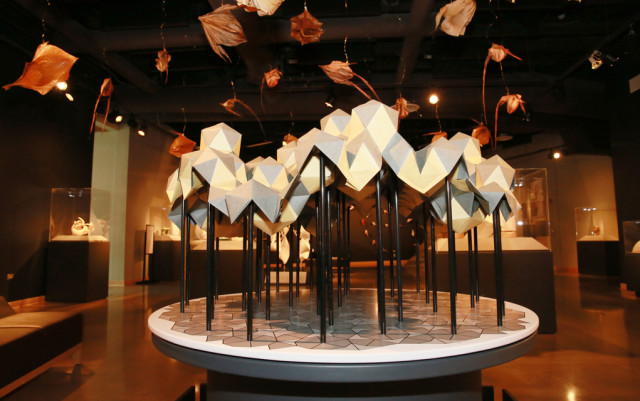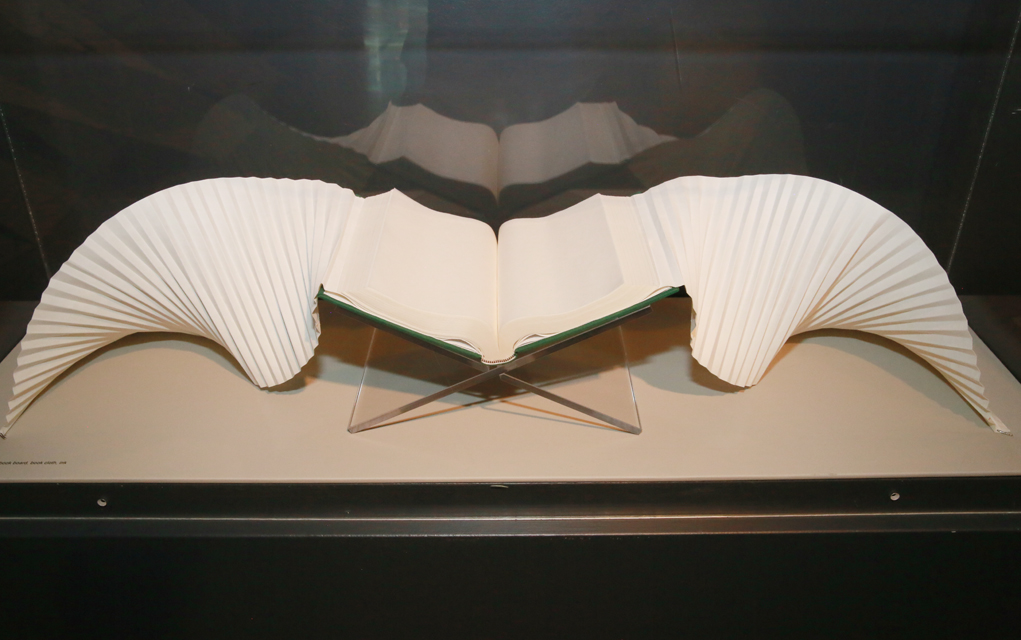
When picturing origami, one often thinks of carefully constructed, but otherwise small and simple paper-folded animals or plants. The current exhibition at the Longmont Museum, however, shows that origami art is more complex than the traditional paper crane.
Above the Fold, showing through May 1, features folding at its finest. The exhibition features many renowned origami artists of both national and international backgrounds.
Paper folding techniques have been discovered throughout various cultures across the world, but the word origami is of Japanese origin, with “ori” meaning to fold and “kami” meaning paper. It is still widely debated when exactly origami was invented, but many historians have drawn its origin back to the invention of paper, around 105 A.D. Origami was said to start as a part of ceremonial exchange in the sixth century, and then later became a part of many folktales, one of the most well-known being the story of the 1,000 paper cranes.
The show in Longmont proves not only how far origami has spread, but also how far it has evolved. Above the Fold highlights the technical intricacies of each piece and challenges the traditional limits of size, shape and concept. Robert Lang, an artist in the exhibit that has been studying origami for several years, says that origami has recently seen an upheaval as a modern art form.
“The origami that people are doing today are things that would have been thought unimaginable 10 years ago. …” Lang says. “I’ve been following origami since the 1960s when I got involved in it, and the artistic field has changed incredibly in terms of the complexity and realism, but also in terms of artistic statements and the types of forms and lines that people are doing today, even if they’re not complex.”

Lang is showing two pieces, one whose quality is also measured by its quantity. “Vertical Pond II” is a series of 60 fish taking up an entire wall. When you follow the line of the folded figures, it feels less like folded paper on a wall and more like fish in a pond.
The work was made with Origamido paper, created and produced by Michael LaFosse and Richard Alexander, who collaborated with Lang on this project to help the artist use colorful ornamental paper to accentuate the shape and beauty of koi fish.
“The paper is just a joy to fold,” Lang says. “It’s beautiful, and it feels wonderful. For some time I had the idea that I wanted to create an origami design that showed off this paper in particular and hit upon the idea of doing a large school of koi fish. Koi are decorative as a subject, and they’re also very individual and unique.”
Lang’s inspiration for origami started with nature and then later, as he studied technical subjects in school, he came to apply that logic to his art.
“Math has played a big role in my origami because it lets me achieve things that I couldn’t do based just on intuition,” Lang says.
Math has rules, and to Lang, origami soon became a similar undertaking. He searched for order in the meticulous folds and found creativity in the details.
For his other piece in the exhibit, “Pentasia,” Lang translated the mathematical practice of Penrose tiling into origami. By working and manipulating the numerical theory, Lang created a 3-D representation. The piece is a work of careful symmetry and utilizes irregular patterns that contain no gaps or overlaps.
On the opposite side of the origami spectrum is Miri Golan and Paul Jackson, who focus more on storytelling. Golan and Jackson are a married couple both showing their own pieces in Above the Fold. The two work together not just on personal artwork, but on origami that teaches cultural awareness.

Golan depicts her relationship with religion with interpretations of holy books in her pieces, “One book,” “Scroll” and “Two Books.”
“Scroll” is made up of the same lightweight paper that composes holy texts like the Bible. While “Scroll” resembles the Torah, it is just an imitation, and isn’t made from the actual text because she knows that religion is a sensitive topic.
“I don’t want to hurt anyone’s feelings,” Golan says. “But I do want to talk with my art.”
Golan’s technique involves twisting paper, which is a literal representation of the way people twist the words of the holy books. In her other two pieces, the paper is winding and reaching out for the other book, representing a unity and parallelism between religions.
“It shows the relationship between the two [holy] books,” she says. “They come from the same origin but are very different.”
Golan comes from Israel, a place where religion is relentlessly in contest, but she’s doesn’t judge people based on religion.
“I work with Palestinians, and I think they are beautiful people,” she says. “The reason I decide people are friends of mine is not because of his religion or his culture. People have forgot this. … It’s the character of the people that will make you love [them].”
Her desire to unite people is displayed in her pieces, and she also works to bring people together through her organization, the Israeli Origami Center. She and Jackson both educate children, teachers and design students on myriad aspects of origami, such as how to use it as a tool to teach geometry.

For Jackson’s work, also in Above the Fold, he often starts with a printed image then expands on it. His piece in the show is a series displaying his hands, called “Untitled.” On one side the hands are fragmented and abstract, and on the other they’re representational, folded but still very clear.
The pieces are meant to reflect the motions of the hands in relation to the art form, displaying the same sort of turning motions made when creating the origami.
“They’re supposed to be a little mysterious, a little poetic and maybe a bit of a conundrum as well when you look at them,” he says.
Jackson shares the goal of pushing origami beyond the traditional and expected form. Starting out, he thought origami was limited as an art, not because of its traditional technique but because of its lack of concept.
“If I have a criticism of origami it’s that even though it’s very beautiful and very interesting, it’s not really about anything,” he says. “So it became my mission when I left college to try to develop technical languages of folding.”
There’s more to origami than meets the eye, however. Origami is unique among paper crafts as it requires no materials other than the paper. Experimentation, the likes of which can be seen in the Longmont exhibition, showcase not only exceptional talent, but also unique stories.
“Working with paper is not a conventional art,” Jackson says. “Everyone who does it has their own story.”
On the Bill: Above the Fold. Longmont Museum, 400 Quail Road, Longmont, 303-651-8374. Through May 14.














